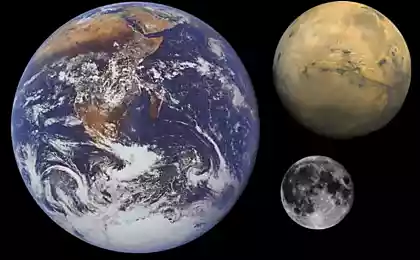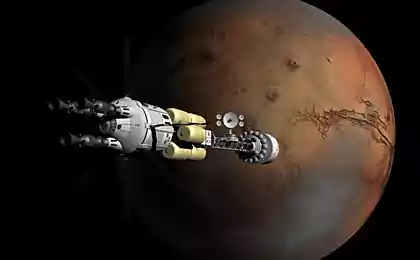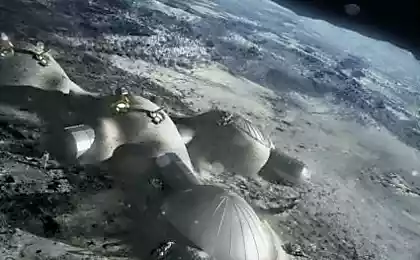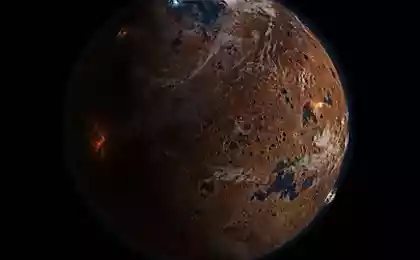1428
Scientists have found that Mars was arid desert more than 600 million years

Recently completed a study in which analyzed in detail the various samples of Martian soil
As a result, scientists have discovered that Mars has dominated the absolute drought of more than 600 million years old, making it among the planets too hostile for the possibility of survival of all forms of life on the surface. Dr Tom Pike of Imperial College London, will discuss the results of research in the European Space Agency.
The researchers took three years for detailed data analysis of Martian soil samples that were collected during the mission, NASA "Mars Phoenix" in 2008. During this mission, the spacecraft "Phoenix" successfully sank in the northern arctic regions of the planet in order to find a suitable surface for life and for soil analysis.
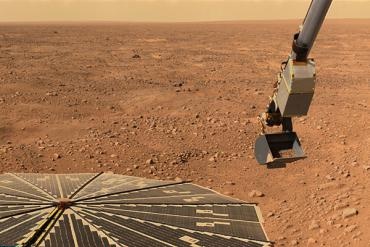
The surface of the Red Planet through the eyes of a spacecraft "Phoenix»
The results of soil analysis in the place where the "Phoenix", suggest that the surface of Mars was waterless for hundreds of millions of years, despite the existence of ice and the fact that Mars probably had a more warm and more humid period in the early history - more than three billion years ago. The team also estimated that the soil on Mars in contact with liquid water is estimated to be about 5000 years after its formation, and it was billions of years ago. The team also discovered that the soil on Mars and the soil on the Moon was formed under similar conditions.
Satellite images and previous studies have shown that the soil on Mars is uniform across the planet, which suggests that the results of the analysis team of British scientists can apply to the entire Mars. This implies that liquid water existed on the surface of Mars is too short period of time that life began, and especially to support it, even a very short time.
Dr. Pike, who is lead author of a study published in the journal Geophysical Research Letters, explains:
"We found that even though there is ice on Mars, the planet was subjected sverhzasuhe that perhaps lasted hundreds of millions of years. We think the Mars we know today is very different from the early history of Mars, where there was a warmer and more humid environment may be more suitable for life. The future NASA mission and ESA, scheduled for the exploration of Mars, should get deep under the surface to find evidence of life, which is perhaps still hidden in the subsurface layers ».
During the flight, "Phoenix", Dr. Pike and his research team were one of 24 teams in charge of the mission in the Mission Control Center at the University of Arizona in the United States; Dr. Pike controlled part of the onboard spacecraft laboratories. Scientists have analyzed samples of soil obtained by the manipulator, using an optical microscope and the atomic to obtain three-dimensional images of the surface of the particles size of 100 microns. The team cataloged the individual particles to better understand the history of Martian soil.

The surface of Mars is too long remained dehydrated to support the emergence or existence of life
The research team was looking for the microscopic clay particles formed by the action of liquid water on a rocky rock. Such particles - an important marker of contact between the liquid water and soil, this ground elements that are easily distinguishable from the others. But the team found no such marker. According to the calculations of scientists, such elements are less than 0, 1 percent of all information in their presence in the alien soil samples. On Earth, the clay can be 50 percent or more of the content of the soil, so this proportion in the Martian samples proves that the Martian surface has a very long history of drought.
The researchers suggested that the soil which they analyzed had contact with liquid water more than 5 000 years.
New evidence supports the idea that the Martian soil is dry most of the history of the planet, if we compare the data on the soil of the Earth and the Moon. The researchers concluded that the soil on Mars and the Moon was formed in a similar way, because they were able to compare the particle size distribution of the soil. On Mars, the physical effects of the winds and the soil meteorites turns into a fine dust on the moon there are similar processes, aggravated by the lack of atmosphere.
This study was supported by the British Council of Science and Technology, the Danish Research Agency, the Swiss Foundation Volfermann-Nagel Space Center EPFL and the National Science Foundation and the National Aeronautics and Space Administration.




